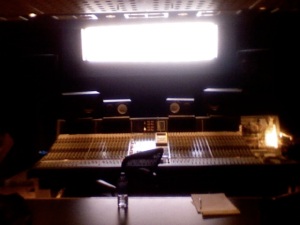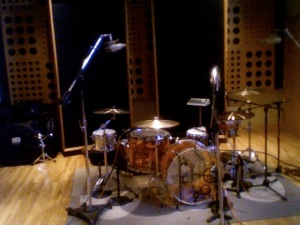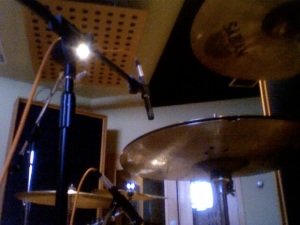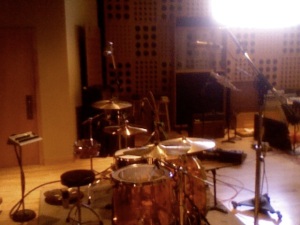You are currently browsing the monthly archive for May 2008.
This week I went on a much-needed Jazz binge. For the end of high school and the first few years of college I listened to Jazz almost exclusively, but much of my listening over the past 4 years or so has been focused on rock/pop. I got a bunch of new Jazz records lately, so it was time for the calculated commercial music to have it’s turn on the shelf. Here’s what I’ve had in the cue this last week…
1) John Coltrane – Ballads …A more reserved side of the famous Coltrane Quartet. Elvin Jones on drums. His feel is so elastic and interpretive. He puts so much of HIS stamp on everything he plays. You can transcribe and learn Elvin’s patterns, but nobody can play them quite like he did.
2) Keith Jarrett – Live at the Blue Note …This is a box-set of the Keith trio, with Gary Peacock on bass and Jack DeJohnette on drums. All the tunes are standards, but with the signature Keith Jarrett Trio expansions. This group improvises so well together – often the tune itself finishes at around the 6-minute mark but the outro-vamp builds and morphs into it’s own thing for another 6 minutes.
3) Lee Konitz – Alone Together …One of my absolute favorite records. Interestingly enough, there’s no drummer. It’s Konitz on saxophones, Brad Mehldau on piano, and Charlie Haden on bass. They play so musically together, such that you really don’t even miss the drummer.
4) Jackie McLean – It’s Time! …A great post-bop album with Roy Haynes on drums. I love Roy Haynes’ energy on this recording.
A ton of people that I respect have told me about this band “Jellyfish” for years… and I never listened to them. Then last year I finally bought their banner recording “Spilt Milk.” I cannot believe it. I listened to it again today and still cannot believe it. It is so incredible on so many levels. If you’re not already familiar with that record, go buy it immediately.
Anyway, the main subject of this post is Andy Sturmer, Jellyfish’s lead singer and drummer. That’s right, playing drums AND singing lead. And standing up while he does it. Watch this video of them live on the BBC and behold the wonder that is Andy Sturmer. This guy’s feel, sound, ideas, everything… all perfect. I believe Andy is currently in an ELO tribute band called “LEO.”
Long live Andy Sturmer.
A helpful website in researching influential drummers, past and present.
Duct tape comes in handy when you’re trying to dampen some snare ring or cut the high end sustain out of your cymbals. BUT… hockey tape is way better. It’s lighter weight, it doesn’t leave any resin, it even comes in American flag or flame designs. Seriously.
Another local Minneapolis drummer named JT Bates clued me in to hockey tape, and now I never play a gig without it. Go get some immediately – you will thank me later.
Update: HOCKEY TAPE SUCKS. It is light weight and does a great job dampening drum heads and cymbals, but it leaves TONS of resin… it just doesn’t show up until you’ve had the tape on there for a few months. The tape you need? GAFF TAPE. OH MY GOODNESS I LOVE GAFF TAPE SO MUCH. Most hardware stores have it, otherwise hit up a Tour Supply near you.
Hey.
The video drum lesson series that I taped for Risen Drums launches today with the first episode. Check it out…
The main reason I started this blog was to field questions on these videos. The first episode is just an introduction and a basic lesson on rimshots, so I don’t anticipate many questions. But, if there’s anything anybody needs clarification on, just put your question in the comments section of this post. I’ll post an announcement like this each time a new video is uploaded. I think Lesson 2 will be up next week sometime.
Update: We filmed these vids in the Fall of ’07… so, five years ago now. I definitely would do them differently if we taped them now, but I stand by the content. All 12 episodes can be found on the Risen Drums youtube channel.
If someone were to ask me what I’ve been listening to lately (not that anybody has), this is what I would tell them…
1) Bjork – Telegram …a bunch of remixes from Bjork’s 1995 release “Post.”
2) Bob Marley – Greatest Hits …Reggae is where feel lives.
3) Zakir Hussain – Magical Moments of Rhythm …live record from the single most respected tabla player in the world.
4) Wilco – Sky Blue Sky …the latest album from the alt-country kings.
5) Suzanne Vega – Nine Objects Of Desire …1996 release from a folk-ish singer/songwriter with vibe to spare.
6) Phoenix – Alphabetical …French rock-synth power pop.
7) Orlando Cachaito Lopez – Cachaito …the renowned Buena Vista Social Club bassist’s solo record.
That’s all for now. I’ll try to post listening stuff like this once a week or so.
Last night I found some RAD videos of Tony Williams playing with the best band ever… the Miles Davis 60’s quintet (Miles, Tony, Herbie Hancock, Wayne Shorter, Ron Carter). Check this stuff out – you will love it. Seriously… thank goodness for Youtube. Live footage of this band is rare, and now because of Youtube we can just click and watch.
Tony was seventeen when he joined Miles’ band in 1962. Yep… seventeen. Miles was an international Jazz superstar at that point, and the drum chair in his band was the most coveted gig in the entire Jazz world (which was the center of the popular music world at the time). 17-year-old Tony took the gig and proceeded to play some of the most ground-breaking and inspiring music in the history of the drumset.
Watch these videos. Watch his ride cymbal. Watch his calm but powerful energy. Watch his control. And… seventeen years old.
Dang it.







Recent Comments